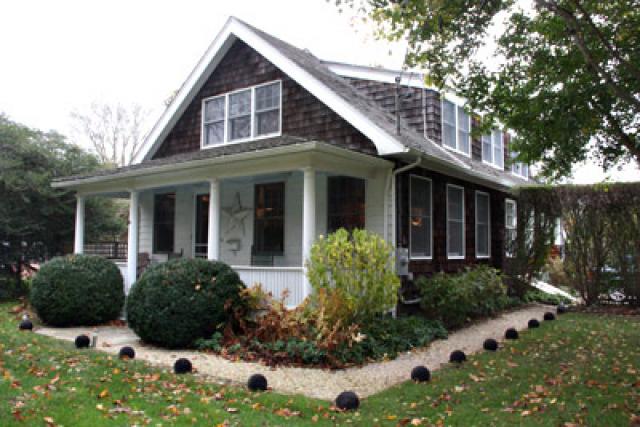From the Sublime to the Ridiculous

A modest bungalow dating from 1911 on Cooper Lane in East Hampton is populated by pictures and objects that have been found at galleries, yard sales, and thrift shops. Before the owner, an architect and interior designer, takes anything home, he asks, “Does it speak to me? Is there a quality that’s interesting or amusing or wonderful? Or is it unbelievably awful?” He collects for each of those reasons. The show begins in the house’s driveway, which, in a kitsch salute to the traditional cannonball lawn ornament, Alan J. Lindenfeld has edged with dozens of bowling balls. Like many of the objects in his collection, he bought some of them while others were given to him by friends, including one that came from the dump. Besides common black balls, Mr. Lindenfeld has glittered and marbleized bowling balls and some that are emblazoned with images of super heroes. Even before East Hampton Bowl closed this summer, and its owners bequeathed him 50 or so, he had counted 85. A scattering of bowling pins is in the garden, but Mr. Lindenfeld has said enough is enough of that. On the house’s first floor, the original catacomb of bedrooms had been converted to an open layout before he took possession in 1992. It contains a library, living room, and dining room. The library, which Mr. Lindenfeld uses as an office, is filled with stacks of books and CDs, but its prevalent theme is canine. Mr. Lindenfeld shares the house with a prize-winning Kerry blue terrier, Blazer, and he has dedicated an entire wall to the dog world, displaying the pooch’s ribbons and images of other breeds. There are vintage photos of dogs with their owners, which he said he acquires when he comes across them and perceives a connection between pet and owner. Dogs run throughout the house, so to speak, with poodles prevailing. Mr. Lindenfeld posits that poodle owners probably commissioned more of the world’s pet portraits than owners of any other breed. The living room, on the other hand, has a more sophisticated tone, with a nesting table and lamp by Tommi Parzinger and an armchair and magazine table by T. H. Robsjohn-Gibbings. Yet, the eye bypasses them to alight on a myriad of mostly mid-20th century pieces, which tend toward the classical rather than the Art Deco, which was popular. His extensive glass collection is a case in point. Mainly Murano and dating from the 1950s through 1970s, objects — from urns to handkerchiefs in muted blues and greens — crop up on tables. Their luminosity seduces him, he said. It is difficult to assign provenance for most of them, however, because “everybody copied everybody.” A few pieces are signed and some can be traced to specific manufacturers and designers. Some examples are a sky blue vase by Venini and a tall aqua-and-gold table lamp by Barovier & Toso. Mr. Lindenfeld pointed to an unusual pink scallop shell. “I used to find them in flea markets and junk stores, but now they’ve become hard to find.” A glass 1940s coffee table displays a cache of molded brass leaves made by Virginia Metalcrafters, a company founded in 1890 in the Blue Ridge Mountains. These are handsome replicas of foliage from English ivy to tobacco leaves, and they probably were made to be candy dishes or ashtrays. The prize specimen among objects that he calls “remarkably hideous” is a lamp made of coral that simulates mushrooms. “It’s truly awful,” he said, a gleam in his eye. One of his more whimsical pieces is a painting of East Hampton scenes, which he picked up at a garage sale. Depicted are Gardiner’s Island replete with treasure chests, as well as Clinton Academy and Hook Mill. Mr. Lindenfeld discovered that it had been painted by Michael J. Smollin, a well-regarded illustrator of children’s books who had designed for “Sesame Street.” Mr. Smollin, who died in 2010, grew up in East Hampton and apparently painted it while in high school. When Mr. Lindenfeld tracked him down, however, the artist could not recall it. The painting combines an expert hand and a slightly absurd aesthetic, themes that run throughout the house. His “museum of domestic appliances” is in the basement. It is filled with parts of 20th-century household devices like Electrolux and Kirby vacuum cleaners. Dozens of hoses hang from a pipe with bits and pieces dispersed high and low. Having bought much stuff secondhand, Mr. Lindenfeld sorts through it all periodically and sends things off to resale outlets like the East Hampton Ladies Village Improvement Society thrift shops and Housing Works in New York. “I’m happy to give them stuff,” he said, “as long as they know what they are getting.”
